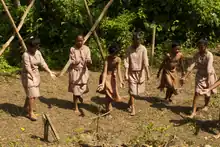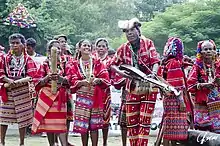Indigenous peoples of the Philippines
The indigenous peoples of the Philippines are ethnolinguistic groups or subgroups that maintain partial isolation or independence throughout the colonial era, and have retained much of their traditional pre-colonial culture and practices.[1]

The Philippines has 110 enthnolinguistic groups comprising the Philippines' indigenous peoples; as of 2010, these groups numbered at around 14–17 million persons.[2] Austronesians make up the overwhelming majority, while full or partial Negritos scattered throughout the archipelago. The highland Austronesians and Negrito have co-existed with their lowland Austronesian kin and neighbor groups for thousands of years in the Philippine archipelago.
Culturally-indigenous peoples of northern Philippine highlands can be grouped into the Igorot (comprising many different groups) and singular Bugkalot groups, while the non-Muslim culturally-indigenous groups of mainland Mindanao are collectively called Lumad. Australo-Melanesian groups throughout the archipelago are termed Aeta, Ita, Ati, Dumagat, among others. Numerous culturally-indigenous groups also live outside these two indigenous corridors.[3] In addition to these labels, groups and individuals sometimes identify with the Tagalog term katutubo, which denotes any person of indigenous origin.[4][5][6]
According to the Komisyon sa Wikang Filipino, there are 135 recognized local indigenous Austronesian languages in the Philippines, of which one (Tagalog) is vehicular and each of the remaining 134 is vernacular.
Terminology
Chapter II, Section 3h of the Indigenous Peoples' Rights Act of 1997 defines "indigenous peoples" (IPs) and "indigenous cultural communities" (ICCs) as:
A group of people or homogenous societies identified by self-ascription and ascription by others, who have continuously lived as organized community on communally bounded and defined territory, and who have, under claims of ownership since time immemorial, occupied, possessed and utilized such territories, sharing common bonds of language, customs, traditions and other distinctive cultural traits, or who have, through resistance to political, social and cultural inroads of colonization, non-indigenous religions and cultures, became historically differentiated from the majority of Filipinos.
ICCs/IPs shall likewise include peoples who are regarded as indigenous on account of their descent from the populations which inhabited the country, at the time of conquest or colonization, or at the time of inroads of non-indigenous religions and cultures, or the establishment of present state boundaries, who retain some or all of their own social, economic, cultural and political institutions, but who may have been displaced from their traditional domains or who may have resettled outside their ancestral domains;
— Republic Act No. 8371 (October 29, 1997). The Indigenous Peoples’ Rights Act of 1997. Archived from the original on July 20, 2017. Retrieved April 1, 2023 – via Official Gazette of the Republic of the Philippines.
Demographics
In the 1990s, there were more than 100 highland tribal groups constituting approximately 3% of the population. The upland tribal groups were a blend in ethnic origin, like those in lowland areas of the country, although the upland tribal groups do not interact nor intermingle with the latter.
Because they displayed a variety of social organization, cultural expression and artistic skills. They showed a high degree of creativity, usually employed to embellish utilitarian objects, such as bowls, baskets, clothing, weapons and spoons. The tribal groups of the Philippines are known for their carved wooden figures, baskets, weaving, pottery and weapons.
Ethnic groups
Northern Luzon

Indigenous peoples in Northern Luzon are found mostly in the Cordillera Administrative Region, where various Igorot groups such as Bontoc, Ibaloi, Ifugao, Isneg, Kalinga, Kankanaey, Tinguian, Karao, and Kalanguya exist. Other indigenous groups living in the Cordillera's adjacent regions are the Gaddang of Nueva Vizcaya and Isabela; Ilongot of Nueva Vizcaya and Nueva Ecija; Isinay, primarily of Nueva Vizcaya; Aeta of Zambales, Tarlac, Pampanga, Bataan, Nueva Ecija; and the Ivatan of Batanes.[7] Many of these indigenous groups cover a wide spectrum in terms of their integration and acculturation with lowland Christian Filipinos. Native groups such as the Bukidnon in Mindanao, had intermarried with lowlanders for almost a century. Other groups such as the Kalinga in Luzon have remained isolated from lowland influence.
There were several upland groups living in the Cordillera Central of Luzon in 1990. At one time it was employed by lowland Filipinos in a pejorative sense, but in recent years it came to be used with pride by native groups in the mountain region as a positive expression of their ethnic identity. The Ifugao of Ifugao province, the Bontoc, Kalinga, Tinguian, Kankanaey and Ibaloi were all farmers who constructed the rice terraces for many centuries.
Other mountain peoples of Luzon such as the Isnag of Apayao, the Gaddang of the border between Kalinga and Isabela provinces, and the Ilongot Nueva Vizcaya and Caraballo Mountains all developed hunting and gathering, farming cultivation and headhunting. Other groups such as the Negritos formerly dominated the highlands throughout the islands for thousands of years, but have been reduced to a small population, living in widely scattered locations, primarily along the eastern ranges of the mountains.
Central Philippines

Upland and lowland indigenous groups are concentrated on western Visayas, although there are several upland groups such as the Mangyan living in Mindoro.
Southern Philippines

Among the most important indigenous groups in Mindanao are collectively called the Lumad. These include the Manobo; the Talaandig, Higaonon and Bukidnon people of Bukidnon; the Bagobo, Mandaya, Mansaka, Tagakaulo of the Davao Region who inhabit the mountains bordering Davao Gulf; the Kalagan people who live in lowland areas and seashores of Davao del Norte, Compostela Valley, Davao Oriental and some seashores in Davao del Sur; the Subanon of upland areas in Zamboanga; the Mamanwa in the Agusan-Surigao border region; and the B'laan, Teduray and Tboli of the region of Cotabato.[10][11]
The Manobo is a large ethnographic group and includes the Ata-Manobo and the Matigsalug of Davao City, Davao del Norte and Bukidnon; the Langilan-Manobo in Davao del Norte; the Agusan-Manobo in Agusan del Sur and southern parts of Agusan del Norte; the Pulanguiyon-Manobo of Bukidnon; the Ubo-Manobo in southwestern parts of Davao City, and northern parts of Cotabato; the Arumanen-Manobo of Carmen, Cotabato; and the Dulangan-Manobo in Sultan Kudarat.[10]
The Yakan is the major indigenous peoples of the Sulu Archipelago and live primarily in the hinterlands of Basilan. The Sama Banguingui live in the lowlands of Sulu, while the nomadic Luwa'an live in coastal areas. The Sama or the Sinama and the Jama Mapun are the indigenous peoples of Tawi-Tawi.[11][10]
Reservations
The Philippine government succeeded in establishing a number of protected reservations for tribal groups. Highland peoples were expected to speak their native language, dress in their traditional tribal clothing, live in houses constructed of natural materials using traditional architectural designs and celebrate their traditional ceremonies of propitiation of spirits believed to be inhabiting their environment. They are also encouraged to re-establish their traditional authority structure in which, as in indigenous society were governed by chieftains known as Rajah, Datu and Loris.
Contact between primitive and modern ethnic groups usually resulted in weakening or destroying tribal culture without assimilating the indigenous groups into modern society. It seemed doubtful that the shift of the Philippine government policy from assimilation to cultural pluralism could reverse the process. Several Filipino tribes tend to lead to the abandonment of traditional culture because land security makes it easier for tribal members to adopt the economic process of the larger society and facilitates marriage with outsiders.
In the past, the Philippine government bureaus could not preserve tribes as social museum exhibits, but with the aid of various nationwide organizations, they hoped to help the people adapt to modern society without completely losing their ethnic identity.
See also
References
- "Philippines". International Work Group for Indigenous Affairs. Archived from the original on March 24, 2023. Retrieved April 1, 2023.
- "Fast Facts: Indigenous Peoples in the Philippines" (PDF). United Nations Development Programme. February 2010. Archived from the original (PDF) on February 25, 2023. Retrieved February 25, 2023.
- National Commission on Indigenous Peoples Archived October 28, 2013, at the Wayback Machine Accessed November 15, 2013.
- Martinez, Angel (April 28, 2022). "Senatorial candidates campaigning from the margins". CNN Philippines. Retrieved July 4, 2022.
- Eder, James F. (September 1990). "Katutubo, Muslim, Kristyano: Palawan, 1621–1901". Journal of Southeast Asian Studies. 21 (2): 449–450. doi:10.1017/s0022463400003416. ISSN 0022-4634.
- Ruanto-Ramirez, J. A. (June 7, 2022), Bonus, Rick; Tiongson, Antonio (eds.), "Twenty-seven. Why I Don't (Really) Consider Myself a Filipinx: Complicating "Filipinxness" from a Katutubo Intervention", Filipinx American Studies, Fordham University Press, pp. 298–307, doi:10.1515/9780823299607-028, ISBN 978-0-8232-9960-7, retrieved July 4, 2023
- Clariza, Elena. "Research Guides: Philippines: Indigenous Peoples of Luzon/The Cordilleras". University of Hawaiʻi at Mānoa Library. Archived from the original on August 4, 2022. Retrieved March 31, 2023.
- "Palawan Culture". Palawan Tourism Council. Archived from the original on July 31, 2008. Retrieved August 28, 2008.
- "Calamian Group and its Tribes". Camperspoint. Archived from the original on July 7, 2009. Retrieved August 28, 2008.
- 2012 DepED-ARMM Orthography for MTB-MLE
- Clariza, Elena. "Research Guides: Philippines: Indigenous Peoples in Mindanao". University of Hawaiʻi at Mānoa Library. Archived from the original on July 30, 2021. Retrieved March 31, 2023.
External links
- Cariño, Jacqueline K. (November 2012). "Country Technical Note on Indigenous Peoples' Issues; Republic of the Philippines". International Fund for Agricultural Development. Archived from the original on September 19, 2020.
- Indigenous Peoples of Mindanao
- IWGIA - Indigenous Peoples in the Philippines
- Kabunianism and Pneumasomatic Sickness - Cordillera People in the Philippines
- "Philippines Indigenous Peoples ICERD Shadow Report for the consolidated fifteenth, sixteenth, seventeenth, eighteenth, nineteenth and twentieth Philippine IC ERD periodic reports" (PDF).
